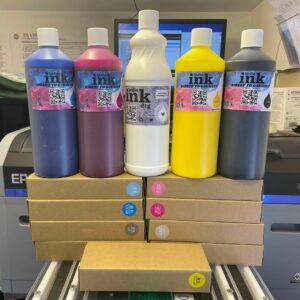Direct-to-film printing, commonly known as DTF printing, is a contemporary printing technology that produces high-quality, long-lasting designs on fabrics like t-shirts, caps, and bags. It uses a specific transfer film to transfer ink directly onto the substrate, resulting in brilliant colors and crisp details. All these requires the right equipment, materials, and processes, which we’ll cover in this blog article. Let’s look at some of the important tips for DTF printing.

9 Important DTF Printing Tips
| Step | Instructions |
|---|---|
| 1 | Choose the right transfer film. |
| 2 | Prepare the transfer film by cleaning it and flattening it if needed. |
| 3 | Adjust the printer settings to match the transfer film and ink. |
| 4 | Use a high-quality, color-corrected image file. |
| 5 | Prepare the substrate by cleaning it and removing any debris or dust. |
| 6 | Use a heat press set to the appropriate temperature, pressure, and time. |
| 7 | Align the print properly on the substrate and apply even pressure. |
| 8 | Finish the print with a protective coating. |
| 9 | Let the print cure for at least 24 hours before washing or wearing. |
Tips for preparing your design
The following advice will help you get your design ready for DTF printing:
Choosing the right file format
Choose the appropriate file format when creating your design. High-quality vector pictures created using programs like Adobe Illustrator or CorelDRAW perform best for DTF printing. These formats make it simple to scale the image without losing quality. Avoid printing from low-resolution photos or file types like JPG since they may produce prints that are distorted or fuzzy.
Properly sizing your design
Make sure your design fits the substrate before printing. Think about the substrate’s size and the location of the design on the product. To change the size of your image as necessary, use design software.
Adjusting the colors and contrast
It’s essential to alter your design’s colors and contrast while creating it for DTF printing. It works best with vivid, bright colors, but keep an eye out for any color gradations or tones that could not transfer well to the substrate. Changing contrast can help your design have distinct, transferable lines.
Using the right software for your needs
It’s important to select the best design program for your needs from the several solutions available for DTF printing. Although Adobe Illustrator and CorelDRAW are popular possibilities, other programs like Inkscape can also work well. Choose a software with user-friendly features and printer compatibility.
These design preparation suggestions will help you produce prints of the highest caliber that are vivid and long-lasting. Don’t forget to use the appropriate software for your purposes, size your design correctly, change the colors and contrast, and choose the appropriate file type.
Tips for preparing your printer
For DTF printing, selecting the appropriate printer
Using a printer that is compatible with the DTF printing process is essential. To avoid the transfer film from becoming tangled or wrinkly, look for printers with a flatbed design or a straight paper path. Check the printer’s DTF ink compatibility and transfer film thickness.
Setting up the required drivers and software
It’s crucial to install the required software and drivers after selecting a suitable DTF printer. For the most recent drivers and software for your particular printer model, visit the manufacturer’s website. You may change parameters like print resolution, ink configuration, and ink density.
Printer calibration

Making sure your prints are of the greatest quality requires calibrating your printer. Calibration adjusts printer settings to mimic your design’s colors and details. For instructions on calibrating your printer, consult the manufacturer.
Selecting the proper ink

For DTF printing to produce prints of a high quality, the proper ink must be used. Use DTF-compatible printer ink. To avoid cracking or peeling when the transfer film is placed onto the substrate, DTF ink should be flexible, opaque, and fade-resistant.
You can ensure the highest-quality DTF prints by setting up your printer according to these suggestions. Choose a suitable printer, install the appropriate software and drivers, calibrate your printer, and use the proper ink.
Tips for preparing your transfer film
The following advice will help you get your transfer film ready for DTF printing:
Selecting the appropriate transfer film

The kind of transfer film you choose might have a significant impact on the quality of your prints when it comes to DTF printing. Choose a DTF transfer film that works with your printer and ink. Select a flexible, resilient film that won’t peel or break during heat pressing.
Getting ready for printing using the transfer film
It’s crucial to prepare transfer film before printing. Make sure the film is clear of dust and debris since they may degrade the print’s quality. To get rid of any dirt or debris, use a lint roller or a clean, dry cloth. Before printing, use a heat press to flatten any creases or wrinkles in the film.
Adjusting the printer’s settings
It’s critical to modify the printer settings while printing on the transfer film to ensure correct ink transfer. For the particular kind of transfer film you are using, adjust the ink density and print resolution accordingly. Use the appropriate color parameters to ensure that the colors in your design are faithfully translated onto the transfer film.
Keeping the transfer film in a safe place
Store the transfer film correctly after printing to avoid damage. The transfer film should be kept in a cool, dry location away from heat sources and sunshine. Keep the film flat and prevent folding or creasing it to preserve print quality.
These transfer film preparation recommendations will ensure high-quality DTF prints. Choose the appropriate transfer film, set it up for printing properly, tweak the printer settings, and store it appropriately after printing.
Tips for printing and pressing
The following advice will help you print and press your DTF prints:
Printing your DTF design
Use the proper printing parameters for your unique transfer film and ink when printing your DTF design. Match the parameters for the print resolution, color, and ink density to the transfer film you’re using. Print your design with realistic colors and details using a high-quality, color-corrected picture file.
Preparing the substrate for pressing
As soon as your DTF print is ready to be applied to the substrate, check to make sure the surface is clean and free of any dirt or debris. For the purpose of cleaning the surface, use a lint roller or a fresh, dry cloth. If required, dry out the substrate by using a heat press or pre-press.
Pressing the DTF print onto the substrate
Heat press your DTF print into the substrate at the right temperature, pressure, and time for the transfer film and substrate. Verify that there are no wrinkles or bubbles and that the print is correctly positioned on the substrate. Apply consistent pressure and heat to achieve transfer film adhesion.
Finishing the DTF print
To make sure that your DTF print is strong and long-lasting, it’s crucial to finish it correctly after pressing it into the substrate. In order to prevent the print from fading, cracking, or peeling, use a finishing spray or powder. Before to washing or wearing the item, allow the print to cure for at least 24 hours.
These DTF printing and pressing tips will produce high-quality, durable prints. Employ the suitable transfer film and ink settings, prepare the substrate, press uniformly, and coat the print.
How long does DTF printing take?
Generally speaking, the duration of the DTF printing procedure might range from a few minutes to many hours, depending on the precise processes required. The size, intricacy, and speed of the printer will all affect how quickly the design can be printed. Preparing the substrate might take time, including cleaning and pre-treating if needed.
With the heat press adjusted to the right temperature and pressure, each print can take a few minutes to press. Adding a protective layer and waiting 24 hours before washing or wearing the print might also lengthen the work.
Can you use DTF on any color shirt?

Dark-colored fabrics can be printed on using DTF printing because it is made to work with a variety of substrate colors. DTF printing is not confined to white or light-colored materials.
Before adding the color layers of the design, a white foundation layer on DTF transfer film is often included. On dark-colored substrates, the colors on this white base layer make them appear vivid and dazzling. As an underbase, the white base layer keeps the color from absorbing into the dark substrate, producing a vivid and opaque print.
DTF printing can print high-quality designs on black, navy, crimson, and other dark clothing. It is therefore a fantastic option for anyone wishing to produce unique garments with a variety of colors and styles.
Conclusion | DTF Best Practices
DTF printing is versatile and cost-effective, producing high-quality, colorful prints on a variety of substrates, including dark fabrics and hard surfaces. With proper preparation and printing, DTF printing may provide fine details and brilliant colors that last.
It may be more complicated than some other printing techniques, but the results are frequently worthwhile. DTF printing is popular for custom clothes, promotional products, and other printing applications since it can print on many surfaces in full color.
If you want to use DTF printing for your next project, make sure you give your design, printer, and transfer film enough time to get ready, and follow best practices for printing and pressing. DTF printing has the potential to be a very effective and enjoyable printing technique that produces products of a high caliber.
FAQs
The best printer for DTF printing is a wide format inkjet with a white ink option. High-resolution and color gamut printers produce the greatest results.
Yes, you should use transfer film that is specifically designed for DTF printing.
DTF printing works on many substrates, although some may not be acceptable. To make sure the substrate is compatible with the ink and transfer film, it is best to test it first.
DTF-printed items can be washed, but it’s vital to follow the manufacturer’s cleaning instructions to preserve the print.
To get brilliant colors with DTF printing, use high-quality ink and transfer film, correctly prepare the substrate, and set the printer’s color saturation and contrast settings.
Cleaning and pre-treating the substrate often fixes adhesion concerns. To prevent ink smearing, adjust the heat press or drying time before pressing. I have written a detail article on DTF sticking problems & fixes.

Ashley Wang is a skilled sales manager with knowledge in DTF printing. She presently works for ShenLan Digital, a reputable DTF printer maker. Ashley is the best person to offer advice on selecting the most suitable DTF printer because she has tested a lot of them. She launched DTFPrinterSchool to educate individuals and organizations about DTF printing technology, providing her expertise and observations on the most recent advancements in the sector. Ashley is an invaluable resource for businesses and individuals wishing to invest in DTF printing technology because of her expertise and experience in the industry.
